This interdisciplinary group of researchers focuses on theoretical and computational of a wide range of atomic and nanometric scale structures; starting with nature of atom bonds to studies on the properties of several types of nanoparticles.
The researchers use a diverse methodology that includes from semi-classical models to first principles approach, depending on the system to be studied. This way, a complex research can be done, covering a wide range of problems from predicting the properties of individual molecules (organic, organometallic and inorganic) to macromolecules, such as proteins, translucent surfaces or polymers, just to name a few.
The projects developed in this area involve both academic research and industrial research. The group participates extensively on international collaborative projects in American (Colombia and Chile) and European (Germany, Portugal, Poland and Ukraine) countries.
Currently, in the area of Theoretical Physics and Chemistry, specialized software is being developed to conduct researches and to solve particular challenges; in addition, they use tools created by other groups with international recognition.
The specialists of this area participate actively and are committed to the formation of high level human resources with master degree and doctoral students. Graduates from national and international universities interested in mathematics, programming and calculus (in the areas of Physics and Chemistry), and who wish to do a research stay, can register in this work group.
Information about courses and studies is available at http://mty.cimav.edu.mx/posgrado/
Tel. +52 (81) 1156 0825
paul.horley@cimav.edu.mx
Dr. Mario Sánchez Vázquez
Tel. +52 (81) 1156 0812
mario.sanchez@cimav.edu.mx
Dr. Andrés Garay Tapia
Tel. +52 (81) 1156 0808
andres.garay@cimav.edu.mx



Research’s lines:
- Magnetization dynamics in ferromagnetic materials at nanoscale. The ferromagnetic systems composed by nanoparticles of different geometry are studied using computational methods developed in the approach framework of macrospin or micromagnetic simulations, optimizing structures to obtain the best magnetic behavior. Research work is also carried out on the magnetoelectric coupling between ferromagnetic particles and photoelectric material, researching the possibility of controlling magnetization with the electric field.
- Self-organization phenomena in dynamic systems. Non-linear dynamic systems that show a complex sequence of ordered and chaotic states depending on the change of their parameters are studied. Research work is being done on the development of advanced numerical methods for the characterization of topology and visualization of the phase portraits of non-linear dynamic systems.
- Simulation of current transmission in semiconductor devices. The models of different types of regular potential barrier for semiconductor materials are being researched with the intention of improving the performance of solar cells.




The research is focused on the reactivity of organic and organometallic structures using computational and experimental methods, developing three main lines of research:
- Evaluation of new materials with the capacity for hydrogen-storage. In this discipline, a search for molecular structures is carried out with the purpose of storing hydrogen; bonding strength is evaluated, particularly that of sigma bonds. New promising molecules can be designed with this information, predicting the required energy to absorb and release hydrogen in a gaseous state.
- Evaluation of the antioxidant capacity in polyphenols. The research group works with polyphenols, some of which have the capacity to counteract the oxidative effects of free radicals in our bodies. We evaluate the antioxidant capacity of some of these structures and study the effects of several substituents strategically placed in the molecules to inhibit or enhance their oxidant capacity.
- Reactivity of organic, organometallic and inorganic molecules. We evaluate reactivity in several molecular structures synthesized in the laboratory to explain their structural and electronic behavior.

- The study of thermodynamic properties in multicomponent systems.
- The study of electronic, magnetic and vibrational properties of nanometric systems.
- The study of new two-dimensional materials
- Development of thermodynamic models through the CALPHAD methodology.
- Development of new metallic, ceramic and semiconductor alloys.
- The study of transition states in surfaces and interfaces.
- Development of models in non-stoichiometric solids through alloy theory.
- Materials modeling through multiscale models.


